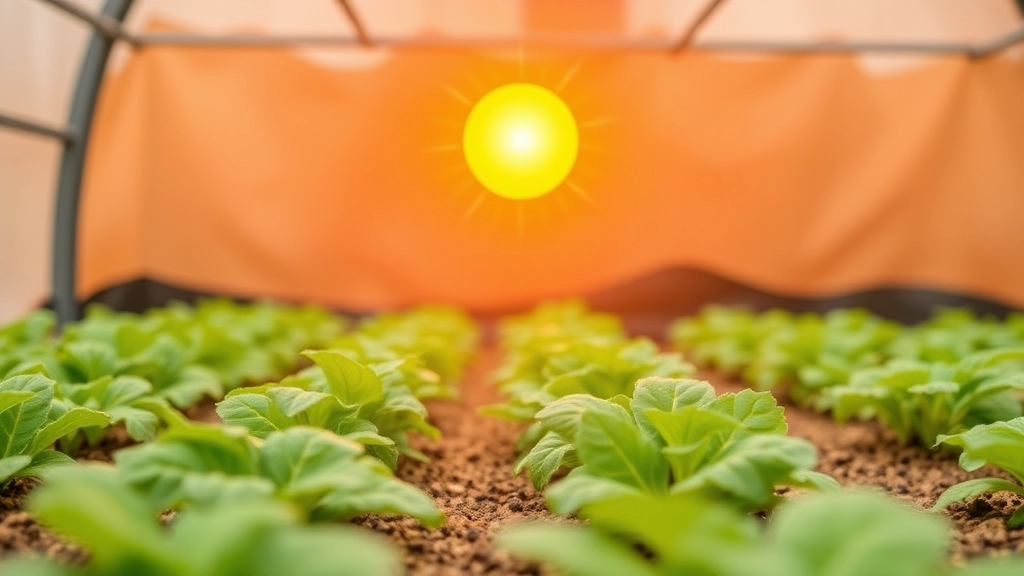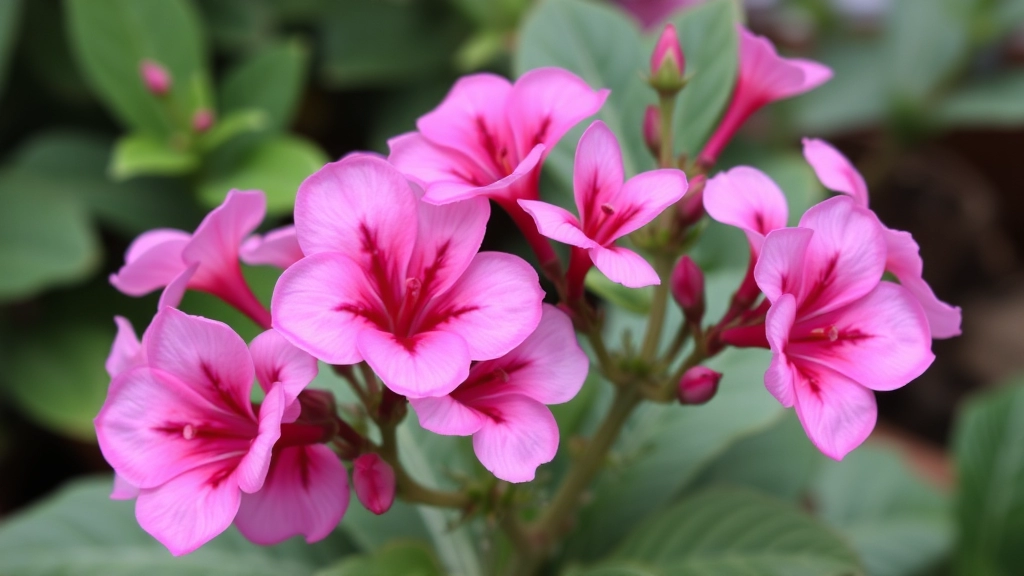How to Grow and Care for Pink Butterflies Kalanchoe
Ever wondered how to grow and care for Pink Butterflies Kalanchoe? You’re in the right place. This unique succulent is a favourite among plant enthusiasts for its vibrant pink plantlets. Let’s dive into the essentials to keep your Pink Butterflies Kalanchoe thriving.
Essential Care Tips
- Sunlight: Ensure your plant gets plenty of sunlight. These beauties love basking in bright, indirect light.
- Watering: Water sparingly—overwatering can lead to root rot.
- Soil: Use well-draining soil to keep the roots healthy.
Follow these tips, and your Pink Butterflies Kalanchoe will be the star of your plant collection.
Overview of Pink Butterflies Kalanchoe
Are you captivated by the vibrant beauty of the Pink Butterflies Kalanchoe?
This unique succulent is not just a visual delight; it also brings a touch of elegance to any space.
What is Pink Butterflies Kalanchoe?
The Pink Butterflies Kalanchoe, scientifically known as Kalanchoe luciae, is a striking succulent known for its stunning, butterfly-shaped leaves that transition from green to a soft pink hue.
These plants are native to Madagascar and are cherished for their resilience and low-maintenance nature, making them an ideal choice for both novice and experienced gardeners alike.
Ideal Growing Conditions

So, you’ve decided to bring home a Pink Butterflies Kalanchoe. Awesome choice! But before you dive in, let’s chat about the ideal growing conditions for this stunning plant.
Light Requirements
- Bright, Indirect Light: Pink Butterflies Kalanchoe thrives in bright, indirect sunlight. Think of a cozy spot near a window that doesn’t get harsh rays.
- Avoid Direct Sun: Too much direct sunlight can scorch those lovely leaves, so keep it gentle.
Temperature and Humidity
- Temperature: These beauties prefer temperatures between 15°C to 25°C.
- Humidity: They’re not picky about humidity, but a little extra moisture in the air can help them flourish.
Soil Type
- Well-Draining Soil: Use a cactus or succulent mix. This ensures excess water drains away quickly, preventing root rot.
- pH Level: Aim for a slightly acidic to neutral pH, around 6.0 to 7.0.
Watering Needs
- Water Sparingly: Allow the top inch of soil to dry out before watering again. Overwatering is a common mistake, so keep an eye on that soil!
- Seasonal Adjustments: In the growing season (spring and summer), you might need to water more often. In winter, cut back significantly.
Fertilization
- Feed Wisely: Use a diluted, balanced fertilizer during the growing season. Just a little goes a long way!
Planting and Propagation Tips
When considering how to cultivate Pink Butterflies Kalanchoe, many people wonder about the best methods for planting and propagation.
Planting Tips:
- Soil Selection: Use well-draining soil to prevent root rot. A cactus or succulent mix works wonders.
- Potting: Choose a pot with drainage holes. This ensures excess water can escape, keeping roots healthy.
- Location: Position your plant in a bright spot with indirect sunlight. Too much direct sun can scorch the leaves.
Propagation Techniques:
- Leaf Cuttings:
- Select a healthy leaf from the parent plant.
- Allow it to dry for a day or two to form a callus.
- Place it in well-draining soil, and water sparingly until roots develop.
- Offsets:
- Look for small offsets around the base of the parent plant.
- Gently remove them, ensuring some roots are attached.
- Replant in a suitable pot with fresh soil.
- Stem Cuttings:
- Cut a healthy stem, allowing it to dry for a few days.
- Plant it in soil and water lightly until new growth appears.
By following these planting and propagation tips, you can successfully grow your Pink Butterflies Kalanchoe and share its beauty with others. For more detailed steps, check out this step-by-step guide to fuzzy Kalanchoe propagation. Additionally, if you’re facing issues with your plant’s blooming, you might find this article on proven tips to get your Kalanchoe to bloom again helpful.
Common Pests and Diseases

When caring for your Pink Butterflies Kalanchoe, it’s essential to be aware of the common pests and diseases that can affect your plant’s health.
Common Pests:
- Aphids: These small, green insects often cluster on new growth, sucking sap and causing leaves to curl.
- Mealybugs: Recognizable by their white, cotton-like appearance, mealybugs can weaken your plant by feeding on its juices.
- Spider Mites: Tiny and often unnoticed, these pests create fine webbing on the undersides of leaves, leading to stippling and leaf drop.
Common Diseases:
- Root Rot: Overwatering can lead to root rot, a serious condition that causes the roots to decay. Signs include yellowing leaves and a mushy stem.
- Powdery Mildew: This fungal disease appears as a white powder on leaves, often due to high humidity and poor air circulation.
Prevention and Treatment:
- Regular Inspection: Check your Kalanchoe regularly for signs of pests or disease.
- Proper Watering: Ensure the soil is well-draining and avoid overwatering to prevent root rot.
- Neem Oil: This natural pesticide can effectively control pests like aphids and mealybugs.
- Fungicides: For powdery mildew, consider using a fungicide specifically designed for succulents.
Seasonal Care and Maintenance for Pink Butterflies Kalanchoe
As we delve deeper into caring for Pink Butterflies Kalanchoe, it’s important to consider how seasonal changes impact your plant’s needs.
Spring: Awakening Growth
Spring is a pivotal time for your Kalanchoe. As temperatures rise, the plant begins to wake up from its dormancy.
- Watering: Increase watering as the soil dries out faster.
- Fertilising: Apply a balanced fertiliser every four weeks to promote healthy growth.
- Light: Ensure your plant receives plenty of indirect sunlight.
Summer: Thriving Conditions
During summer, your Pink Butterflies Kalanchoe will flourish with the right care.
- Watering: Water deeply but infrequently. Let the soil dry out between waterings to prevent root rot.
- Humidity: Keep humidity levels low; Kalanchoe prefers drier air.
- Pest Check: Regularly inspect for pests, as they can thrive in warmer conditions.
Autumn: Preparing for Dormancy
As temperatures begin to drop, it’s time to prepare your plant for the colder months.
- Watering: Gradually reduce watering frequency.
- Fertilising: Stop fertilising by mid-autumn to allow the plant to rest.
- Light: Ensure it still gets adequate light, but avoid direct sun during the hottest part of the day.
Winter: Minimal Care
In winter, your Pink Butterflies Kalanchoe enters a period of dormancy.
VI. Decorative Uses and Benefits of Pink Butterflies Kalanchoe

So, you’ve got your Pink Butterflies Kalanchoe and you’re wondering how to showcase this beauty in your space, right?
Let me tell you, these plants are not just pretty faces; they bring a whole lot of charm and benefits to the table.
Decorative Uses:
- Indoor Accent:
- Place it on your coffee table or windowsill.
- The vibrant pink leaves add a pop of colour to any room.
- Office Decor:
- Brighten up your workspace with a small pot.
- It’s low-maintenance, so you won’t have to worry about neglecting it during busy days.
- Gift Ideas:
- Perfect for housewarming or birthday gifts.
- Wrap it up with a nice ribbon, and you’ve got a thoughtful present.
- Terrariums:
- Combine with other succulents for a stunning display.
- Create a mini ecosystem that’s easy to maintain.
- Outdoor Spaces:
- Use in patio planters or hanging baskets.
- They thrive in sunny spots, making them ideal for outdoor decor.
Benefits:
- Air Purification:
- Like many succulents, they can help improve indoor air quality.
- A natural way to keep your home fresh.
- Stress Relief:
- Studies show that having plants around can reduce stress.
- Just looking at those lovely pink leaves can lift your mood.
- Low Maintenance:
- Perfect for busy folks or beginners.
- Watering only when the soil dries out means less fuss.
- Versatility:
- Fits in with various decor styles, from modern to rustic.
- You can easily switch up pots to match your theme.
### Troubleshooting Common Issues with Pink Butterflies Kalanchoe
When caring for your Pink Butterflies Kalanchoe, you might encounter a few common issues that can hinder its growth and vibrancy.
Is your plant wilting or showing signs of stress?
Here are some potential problems and their solutions:
FAQs about Pink Butterflies Kalanchoe
What are the ideal light conditions for Pink Butterflies Kalanchoe?
Bright, indirect light is best for Pink Butterflies Kalanchoe. Avoid placing it in direct sunlight to prevent leaf scorch.
What temperature and humidity levels do Pink Butterflies Kalanchoe prefer?
These plants thrive in temperatures between 15°C to 25°C. While they aren’t too picky about humidity, a bit of extra moisture in the air can be beneficial.
What type of soil is best for Pink Butterflies Kalanchoe?
Use a well-draining soil mix, such as a cactus or succulent mix. Aim for a pH level between 6.0 to 7.0.
How often should I water my Pink Butterflies Kalanchoe?
Water sparingly, allowing the top inch of soil to dry out before watering again. Adjust watering frequency based on the season, with more frequent watering in spring and summer and less in winter.
Do Pink Butterflies Kalanchoe need fertilization?
Yes, use a diluted, balanced fertilizer during the growing season. A little goes a long way!
What are common pests that affect Pink Butterflies Kalanchoe?
Common pests include aphids, mealybugs, and spider mites. Regular inspection can help catch these issues early.
What diseases should I watch out for with Pink Butterflies Kalanchoe?
Be cautious of root rot caused by overwatering and powdery mildew due to high humidity and poor air circulation.
How can I prevent and treat pests and diseases in my Pink Butterflies Kalanchoe?
Regularly inspect your plant, ensure proper watering, and consider using neem oil for pests and fungicides for diseases like powdery mildew.
What are some decorative uses for Pink Butterflies Kalanchoe?
They make excellent indoor accents, office decor, gifts, terrariums, and can even be used in outdoor spaces like patio planters or hanging baskets.
What benefits do Pink Butterflies Kalanchoe offer?
These plants can help with air purification, stress relief, and are low maintenance. They also offer versatility in fitting various decor styles.
References
-
The Spruce: Growing Kalanchoe ‘Pink Butterflies’
-
Gardening Know How: Kalanchoe ‘Pink Butterflies’ Care
-
House Plants Expert: Kalanchoe ‘Pink Butterflies’
